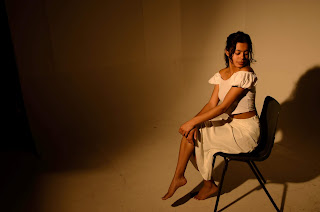GENERATING FINAL PROJECT: PRACTICE SHOOTS AND RELATED THEORY
STUDIO SHOOT 1
BODY LANGUAGE PRACTICE
The above photos how my first practice in the studio setting trying out various body positions with my chosen subject. I have adjusted the white balance to a cooler 2,800k, and used a grey gel coloured film over a 300w Redhead light. I directed my subjects pose, to be evocative of a masculine body, legs wide apart, with confident, casual slumped arm resting on a cocked knee. We tested different angles of the head and directions of gaze, discovering a direct gaze with the chin tilted upwards evoked the best connotations of a confident, powerful man.
STUDIO SHOOT 2
COSTUME AND BODY LANGUAGE
The above images show the contact sheets made from the photos I shot during the second shoot. This time, I was able to shoot my subject in full costume, a men's tailored black suit, white shirt and tie, to see the effect of these colours against the white infinity curve and my chosen lighting.
I wanted to produce a range of compositions, through distant full-body shots, to close facial portraits, standing and seated subject, to see which combination provided the most provocative and exciting product.
I particularly liked the variance and compositions of these three photographs. I like the squareness of the shape made by the subjects leg position in the first photo, and the angular/diagonal created by the elongated shape of the legs in the third. I love the close, direct and demanding nature of the second photo, but plan to recreate this with sharper focus and more dramatic lighting through higher contrast. I prefer the effect of only using the white balance settings (2650k) to adjust the colour of the image rather than using gel coloured sheets, as I feel it gives a more vibrant colour that you can adjust the intensity of easily.
The effect of a direct eye contact/gaze and a camera angle that looks up to the subject, allowing the subject to look down on the viewer, is effective here, and is something that I will continue to use in future shoots.
On reflection of this shoot, I plan to increase the intensity and brightness of the light props used, with sharper focus and attention to shadows for my next shoot.
STUDIO SHOOT 3
FINAL SHOOT: MASCULINE AND FEMININE ROLES DEPICTED
So far, I have only explored a representation of a male persona through a female subject in my practice shoots. Initially, I liked the idea of only using this portrayal, as I thought a portrayal of a female subject in a feminine way was un-interesting and had been done before. However, after receiving feedback from my tutor, and researching further into the work of Cindy Sherman, I have decided to portray a stereotypical view of a woman in the media through the use of the same female model used in my male portrayal. I hope the juxtaposition of including both of these contrasting sets of images together in one series allows my message of gender imbalance to be even clearer.The photos above show my final shoot to achieve the male persona which makes up one half of my final project. I was able to rectify focus errors made in the previous shoot, and use a more intense direction of light (800w Redhead) to achieve a more dramatic, high-contrast image.
The above images show the contact sheets of my shoot with the female subject captured in a stereo-typically feminine, sometimes sexualised poses. In contrast to the cool blue-ish hue used for the masculine portrayal, I have adjusted the white balance on the camera here to be much warmer, 5600k.
I have also directed the model to have a disconnected, distant, in-direct eye contact/gaze with the camera, to evoke a certain passivity and vulnerability, in contrast to the demanding direct gaze of the male persona.
All shots are taken slightly or largely from above the subject, forcing the viewer to look down onto the image and the woman, shifting the power to the viewer who dominates over the female figure.
Similarly to the masculine shoot, I produced a range of compositions in the way there are close up focus shots of the subjects features, as well as body compositions of her seated and laid on the floor.
My inspiration for the particular body positions that I directed my subject to pose in was inspired by the body language used by Cindy Sherman in her 1977-1980 work Untitled Film Stills (please see separate blog post).
The images above show the unedited images that I selected as contenders for inclusion in my final project, but didn't quite make the cut. I wanted to make sure I had a variety of compositions in the final selection, with a balance of distant full body shots and close-up facial portraits, as well as an interesting variation of camera angles/directions and body positions.
I also wanted to choose carefully each 'man' photo in relation to each 'woman' photo, as I want the viewer to be able to make direct and obvious comparisons between the two themes in order to see how the theatre and production around the photographs has influenced their connotation.
Above are screenshot images showing the editing of two of my final photographs using Adobe Photoshop. I used the 'Levels' sliders to carefully adjust settings such as exposure, whites, contrast and shadow, and was able to perfect my composition using the crop and rotate tools.
To see the final edited photographs that make up my final project, please see separate blog post 'THE FINAL PROJECT'.






























Comments
Post a Comment